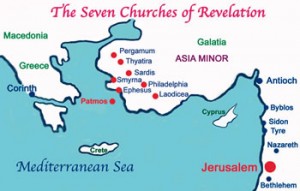The Book of Revelation (1)
INTRODUCTION
Musical praise of God is an important part of the Book of Revelation. Even those who know nothing of the text and message of the book may know some of the hymns based upon some of its passages: ‘All Hail the Power of Jesus’ Name,’ ‘Holy, Holy, Holy,’ and, of course, Handel’s ‘Hallelujah Chorus.’ Some Christians are wary of what they have heard about the book. But we will find that the book is all about the triumph of the Risen Christ.
Revelation is a pastoral letter that speaks prophecy in the medium of apocalyptic. That’s quite a mouthful, so we’ll break it down.
First, Revelation is a letter. We don’t mean just the messages, the ‘letters’ to the seven churches named in chapters 2 and 3. The entire book is a letter. At 1:4 we read, ‘John to the seven churches that are in Asia: Grace to you and peace…’ This greeting is familiar from the letters of Paul, who had labored in the work of evangelization in the same area. The concluding verse (22:21) is also familiar from Paul’s writings, ‘The grace of the Lord Jesus be with all the saints. Amen.’
Regarding the letter, we can ask the usual questions: who? what? when? where? why? The author is an otherwise unknown Christian leader named John (not the apostle, the son of Zebedee). He has been exiled by the Roman government to an island named Patmos, about 20 miles west of Asia Minor. The recipients are seven congregations on the mainland of Asia (a Roman province in today’s Turkey). Presumably the message also circulated to other Christian communities in the area (for example, Colossae).
The letter was written around 95 A.D., late in the reign of the Emperor Domitian. There is no evidence of a widespread persecution of the Church by Domitian (unlike Nero, Marcus Aurelius and others). But persecution there was, both outright attacks on Christians (one Antipas had actually been murdered), and also subtler ones, mainly economic. How could Christian merchants, for example, prosper if they could not join the merchants’ guild, which was pagan? This persecution in the province of Asia (western Turkey) resulted from the refusal by many (sadly, not by all) Christians to worship the emperor as a god.
Into this situation a Christian prophet named John spoke. Like the prophets of the Old Testament, John primarily did not predict exact events. Like the prophets of old, John spoke the word of God to the situation of his time and place. That a prophet is responsible for speaking the word of God to his contemporaries is obvious from his condemnation of false prophets among the seven Churches of Asia. Jezebel, for example, is not condemned because of false predictions but rather because she was distorting the word of God and leading her followers astray from the Lord.
The book of Revelation was written in the literary form called apocalyptic. We deal with literary forms every time we read a newspaper. One literary form is the sports page, another feature stories. A third is editorial, a fourth is comic strips, and so on. We would be sadly misinformed if we forgot what literary form a sports page is. If a sports report says ‘St. Michael crushes St. Gabriel’ we would be mistaken to think it’s a reference to a fight among the angels. Rather two schools’ sports teams competed and St. Michael’s won by a wide margin.
Apocalyptic is a literary form that flourished from about 200 B.C. to about 100 A.D. Apocalyptic features highly colorful symbols, none meant to be taken as exact representations of reality. In chapter 1, for example, the Risen Christ is pictured holding seven stars in his right hand. These are not literal gaseous orbs but rather the seven churches of Asia. In Albrecht Durer’s wonderful woodcut of the scene, Christ holds the word of God in book form in his left hand, while coming forth from Jesus’ mouth is a two-edged sword.
(In the woodcut, it almost looks as though the sword is hinged to the corner of Jesus’ mouth.)
No one thinks that the Risen Lord walks around holding stars and a book, nor that he has a sword hanging perpendicular to his mouth. This is apocalyptic imagery that says Jesus is Lord of the churches, he proclaims the word of God and that word is like a sharp sword.
Apocalyptic also uses colours and numbers as symbols. Was all this meant to sneak the message past Roman censors while allowing Christians to ‘decode’ the meaning? An interesting idea, but very unlikely. Only an incredibly stupid censor would not recognize that a city on seven hills was Rome. And why did John deliver such a harsh message against the Empire? Elsewhere the New Testament John even urges Christians to pray for the emperor and other civil officials. We will examine why John feels Rome is a beast in subsequent articles.
How shall we proceed? Revelation was meant to be read aloud in public worship, much like the letters of Paul. In order to get a true feeling of the impact of the message in the seven churches, it is necessary to read it aloud (by yourself if necessary; in a group if possible). Allow no interruptions. Do not mention chapter numbers or headings (these are modern additions.) Notice that John often brings us to the very edge of the end of the story, only to double back and use more symbols to give the same message in stronger terms. Do not fall into the fundamentalist trap of trying to calculate when all this will happen. That’s not John’s concern, nor ours.
To prepare for the next article, after reading Revelation (and note this is singular – not ‘revelations’) all the way through, read in a more studied way chapters 1 through 3, the initial vision of the Risen Christ and the letters to the seven churches.


 Entries(RSS)
Entries(RSS)